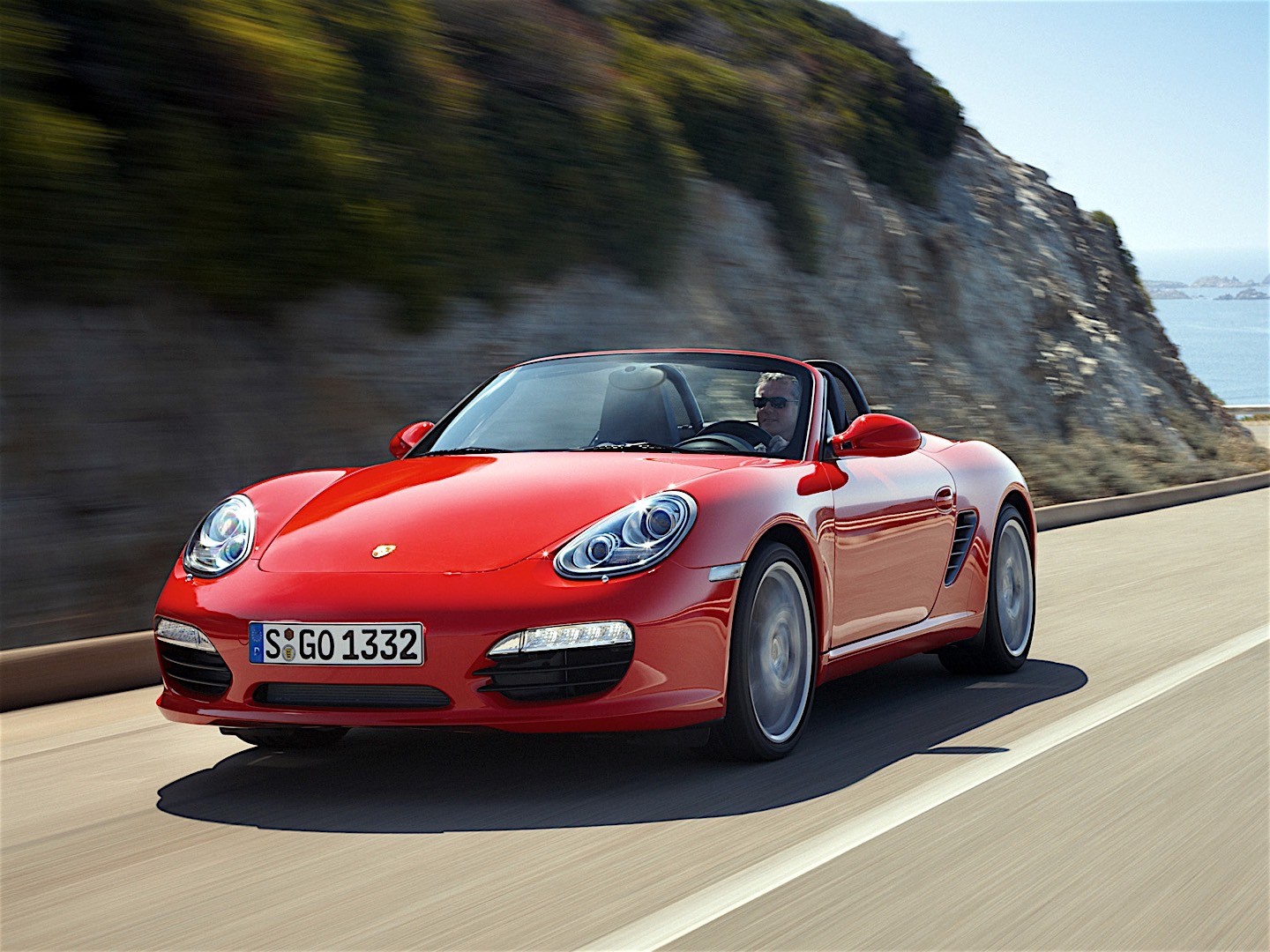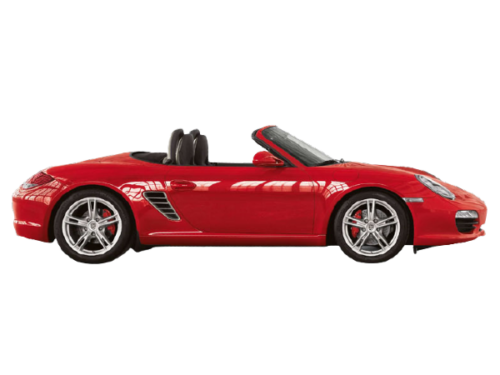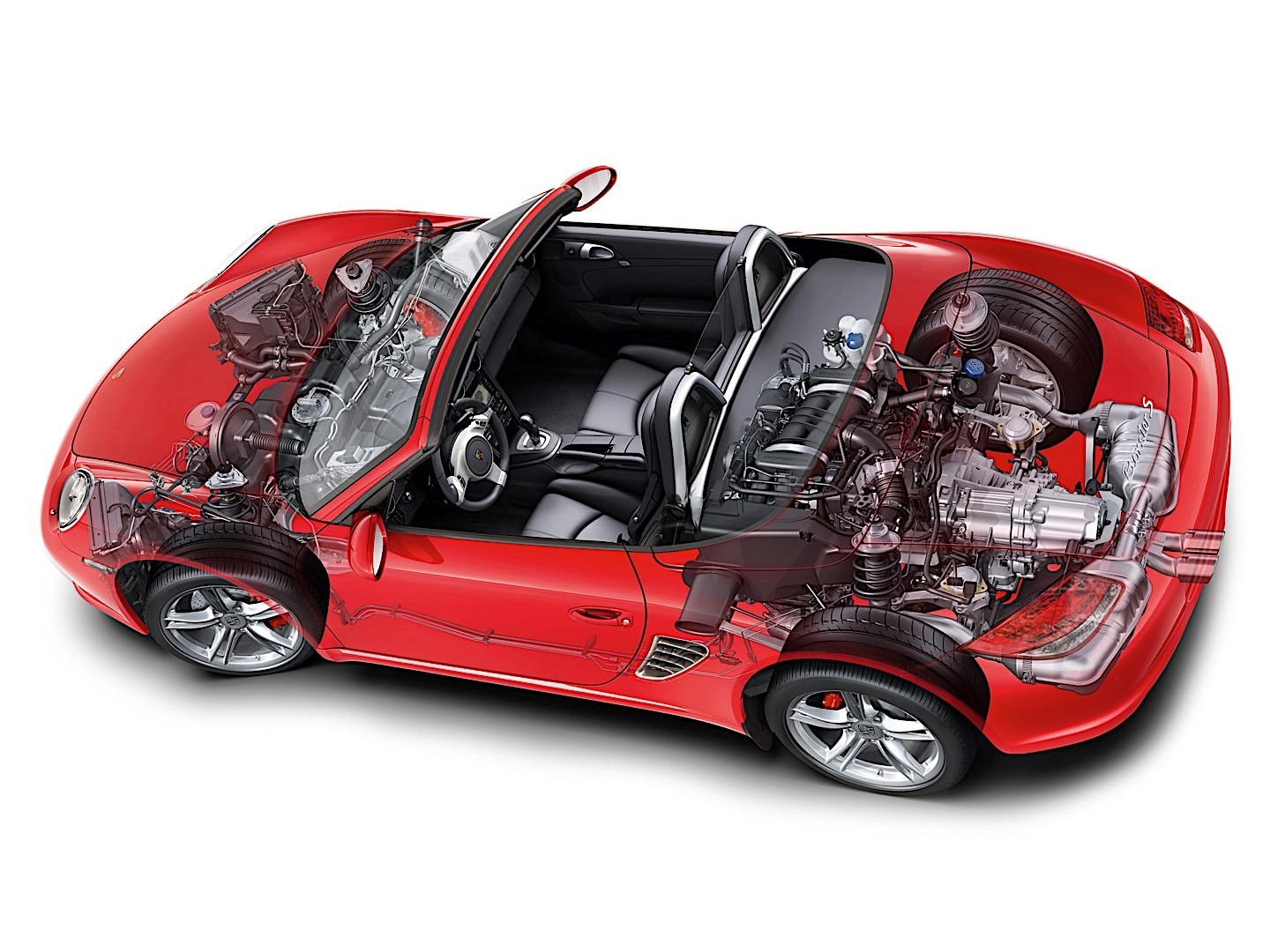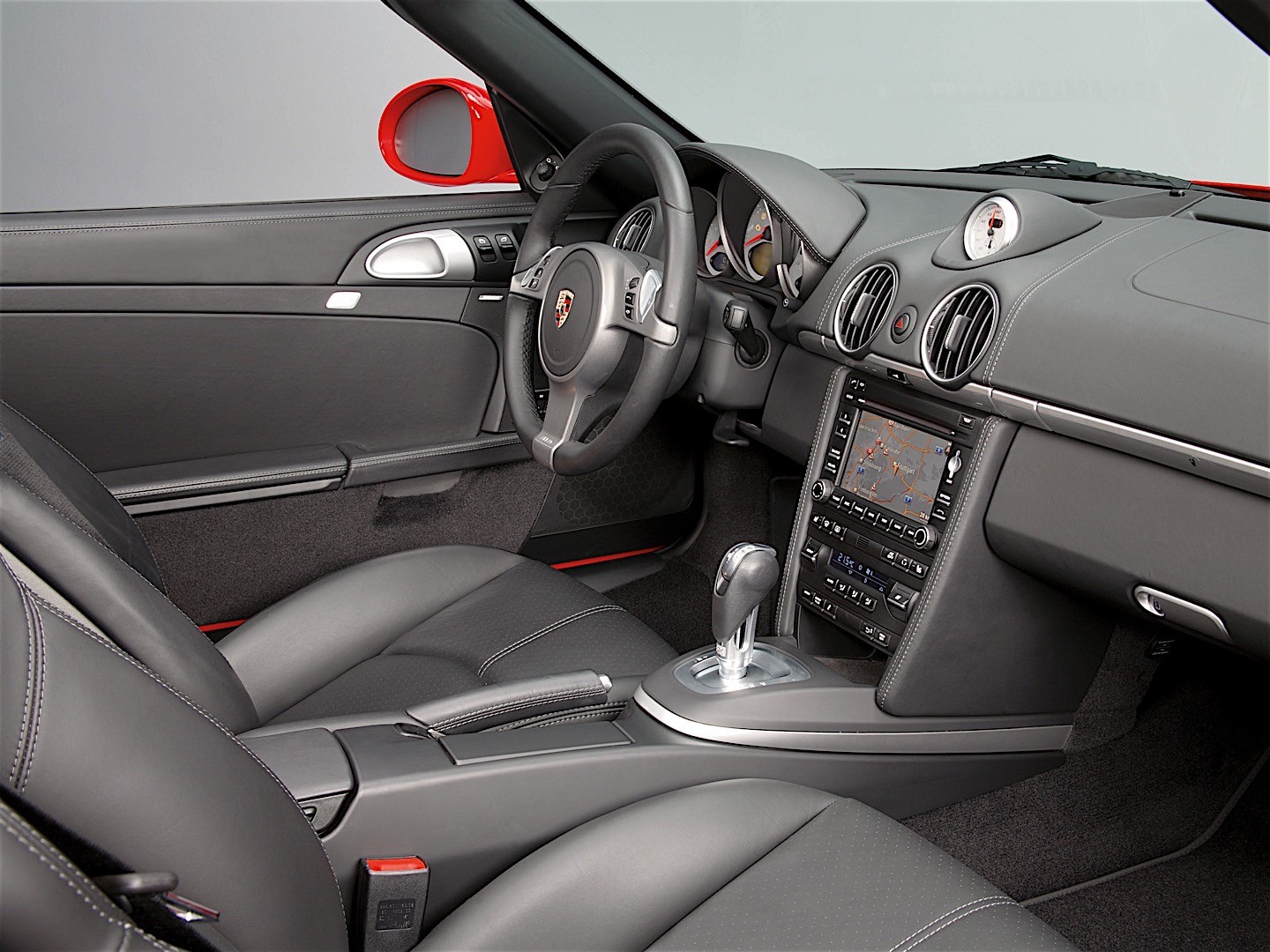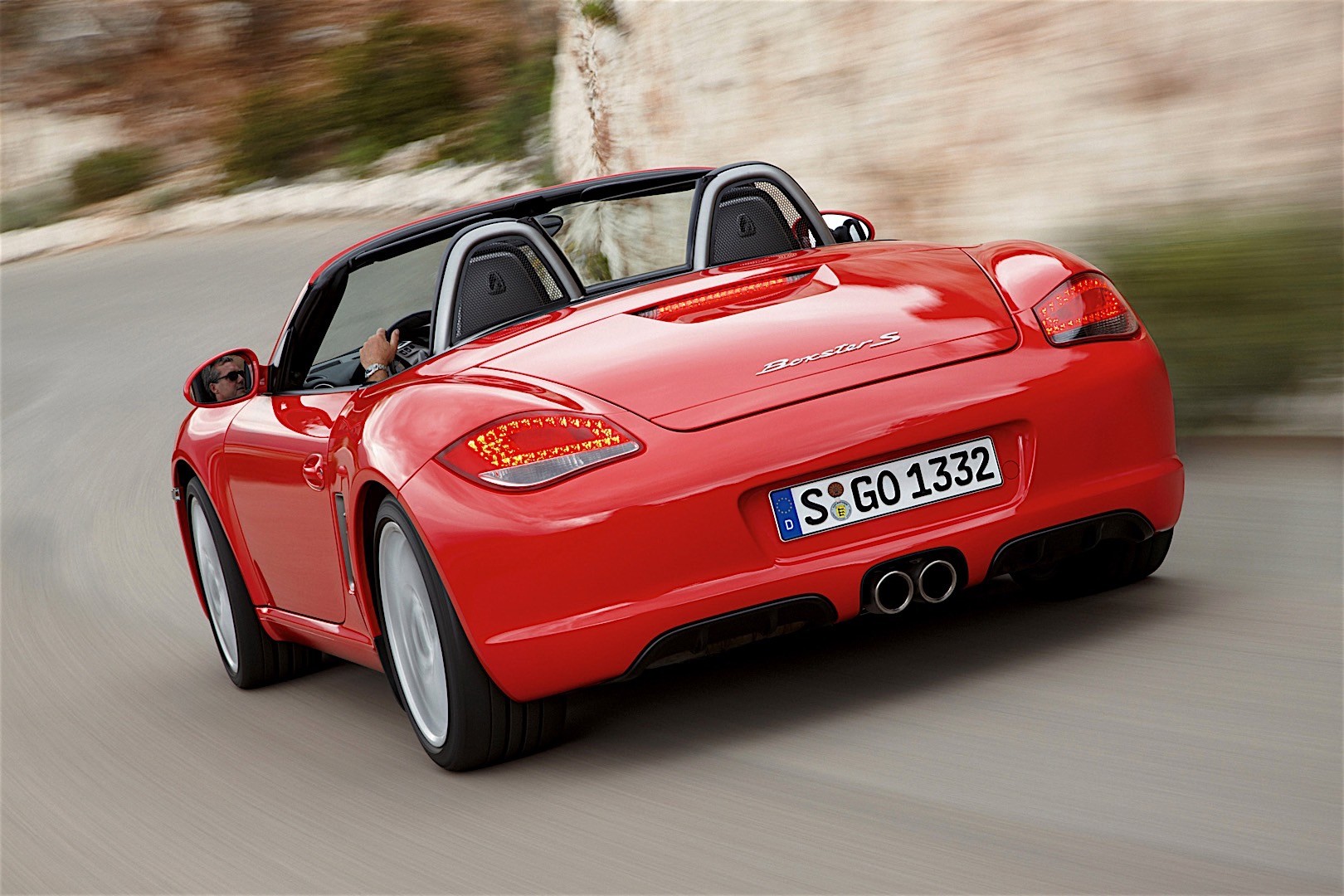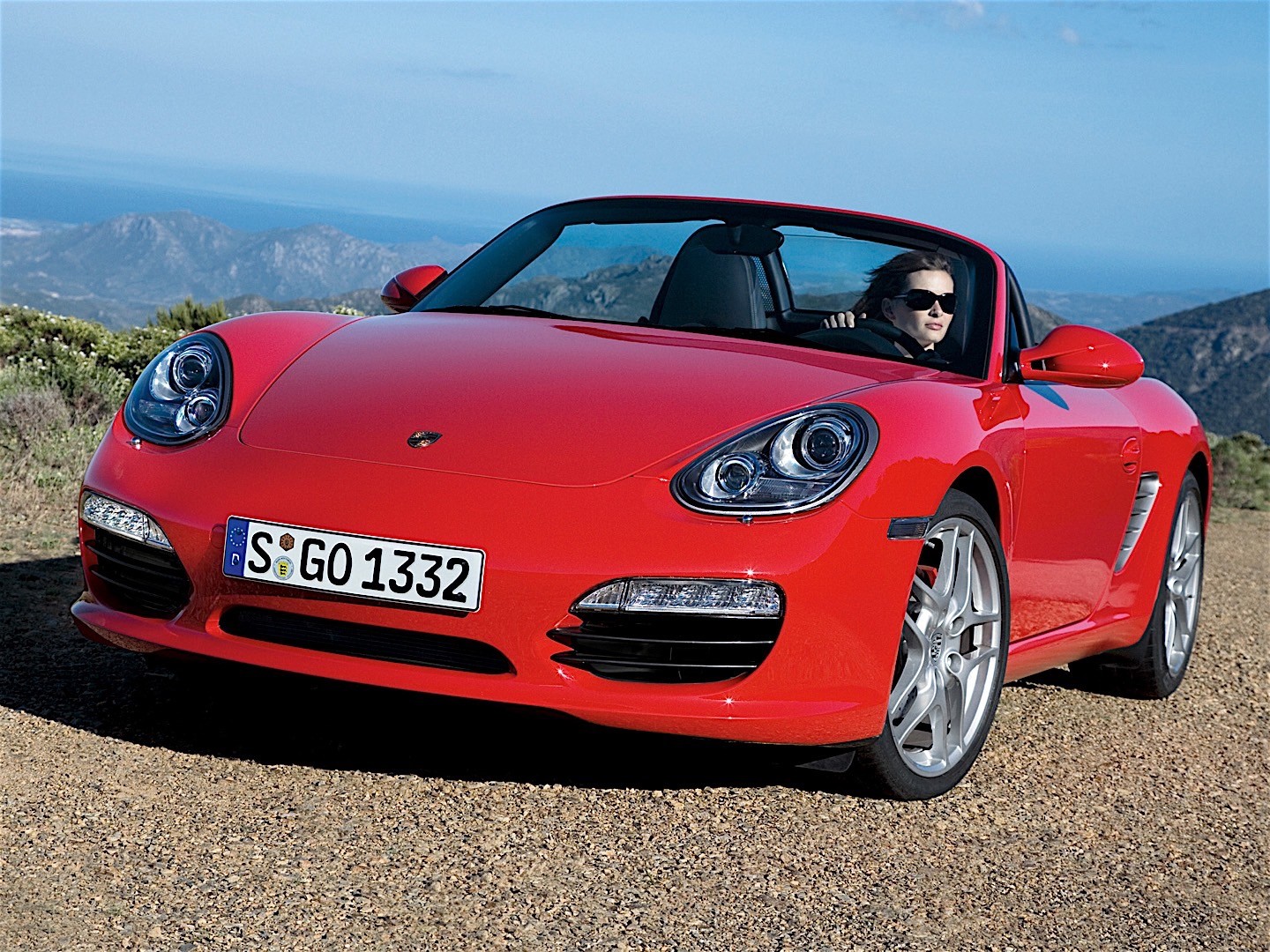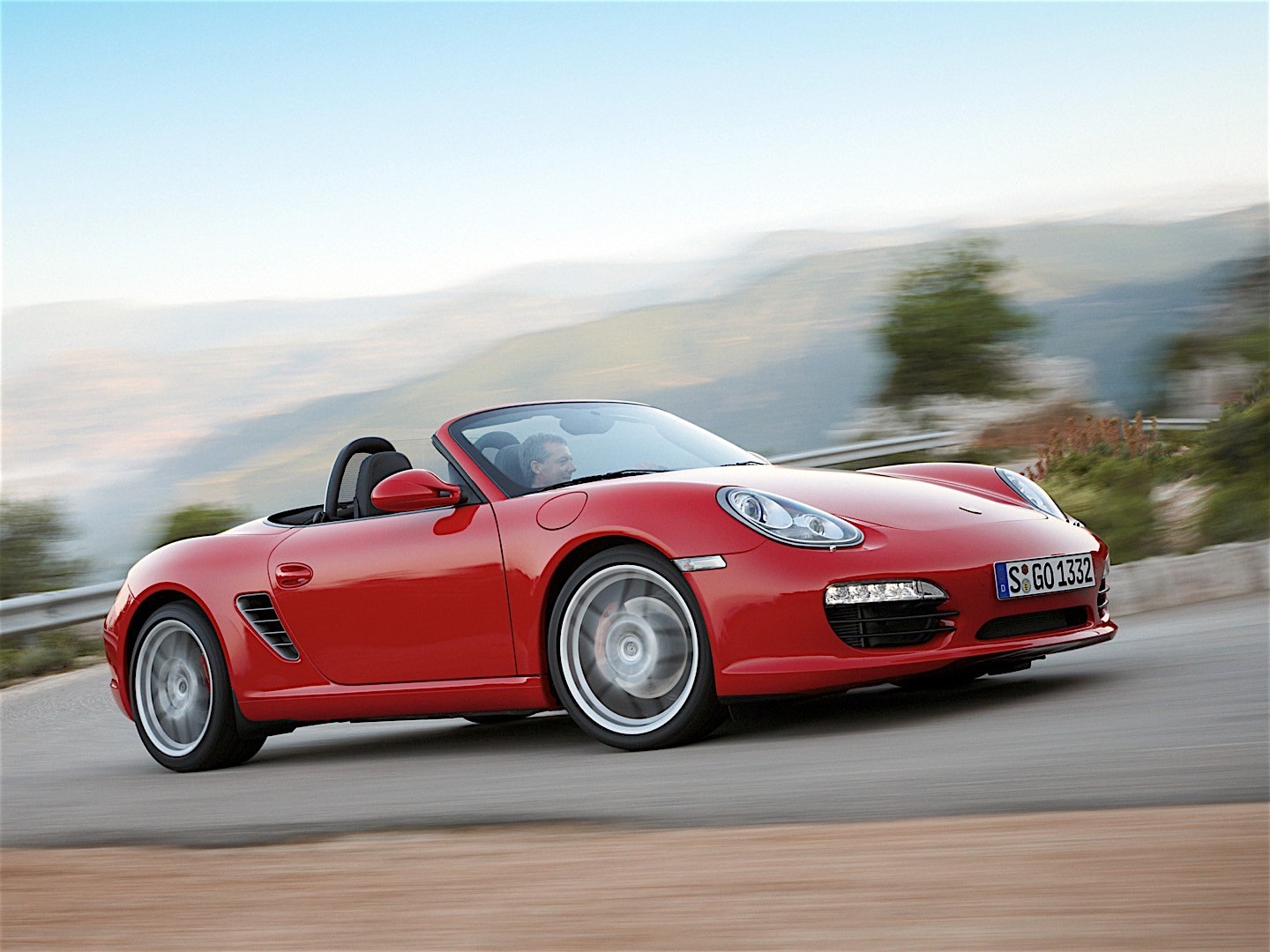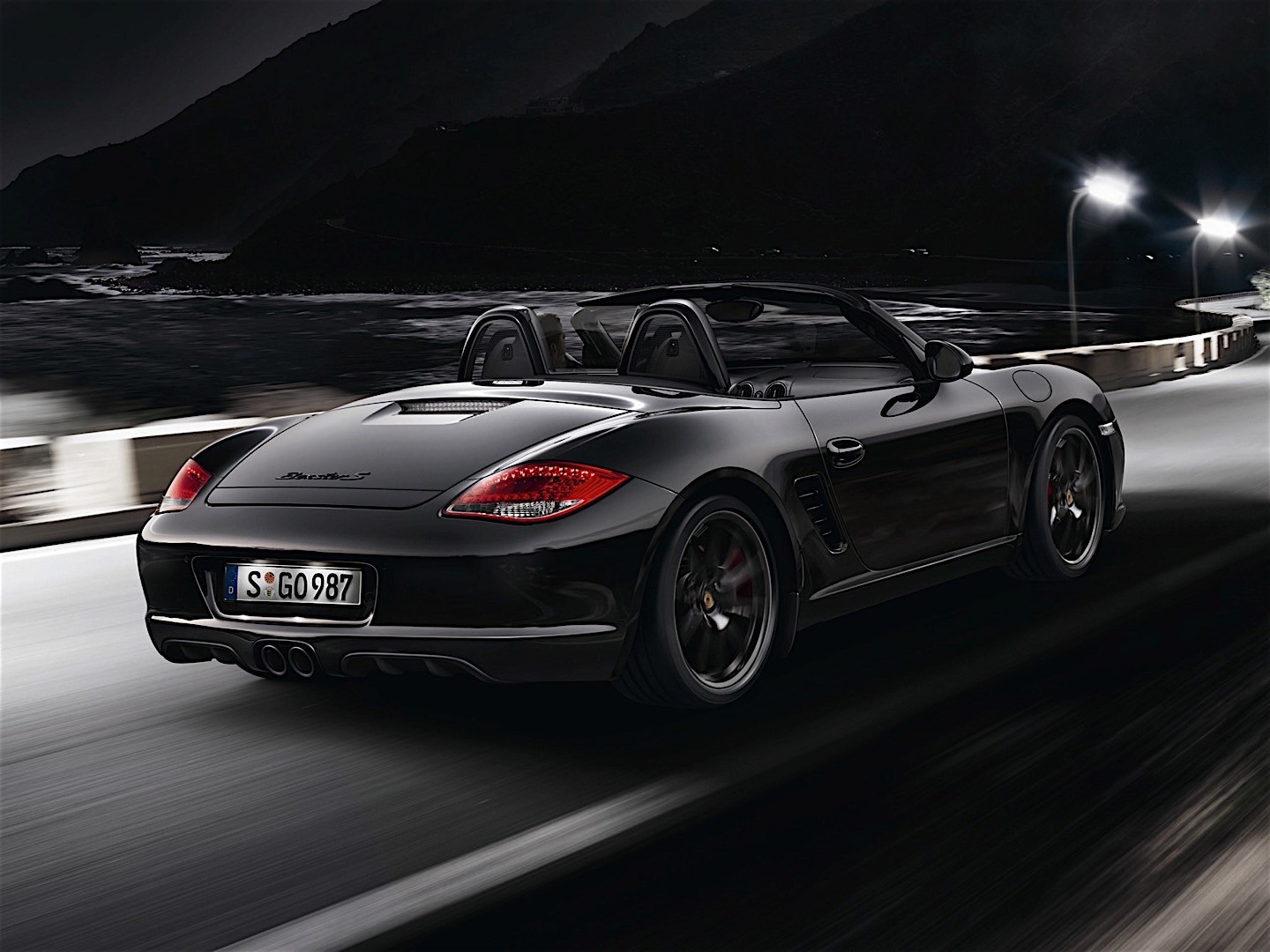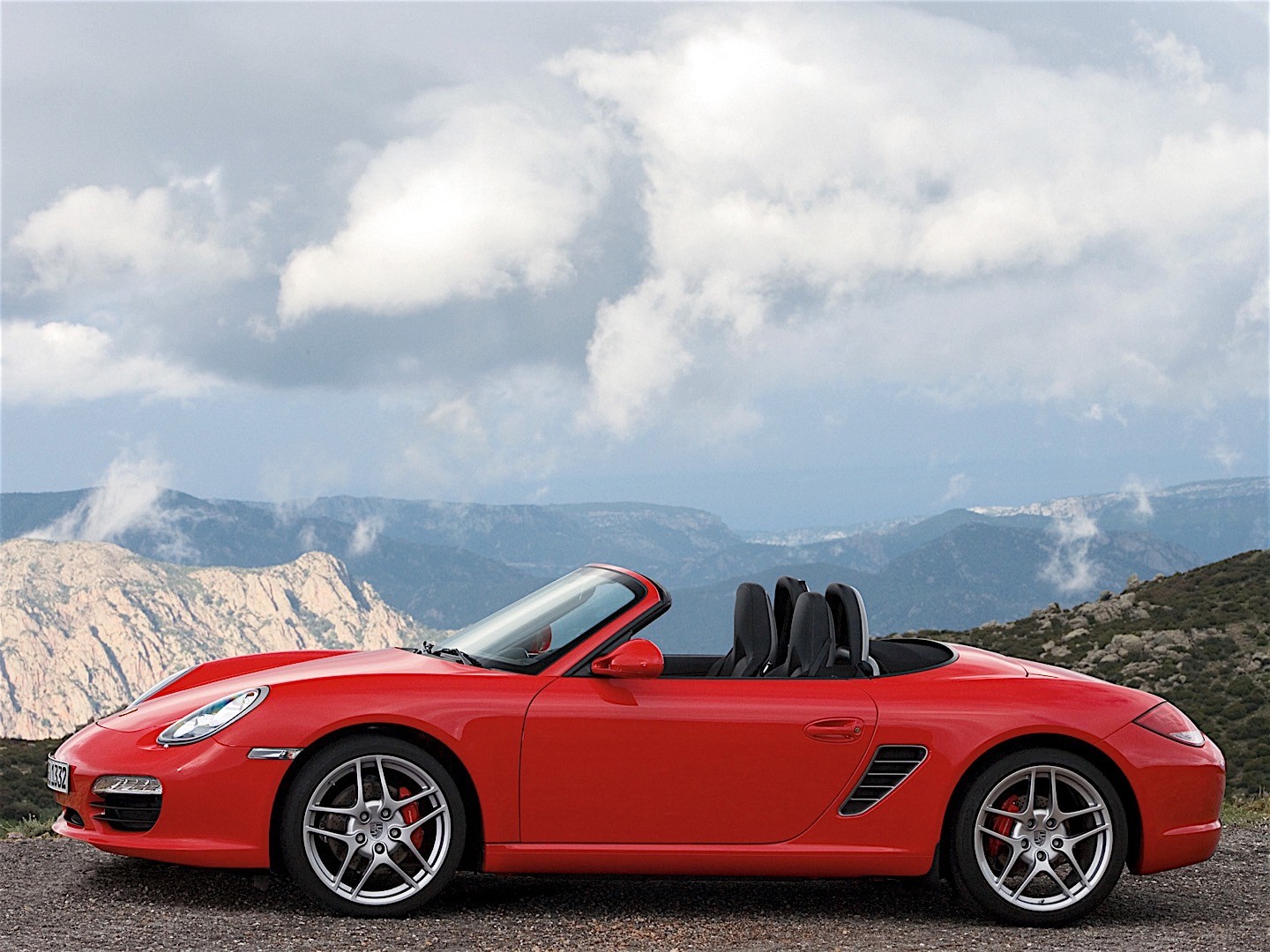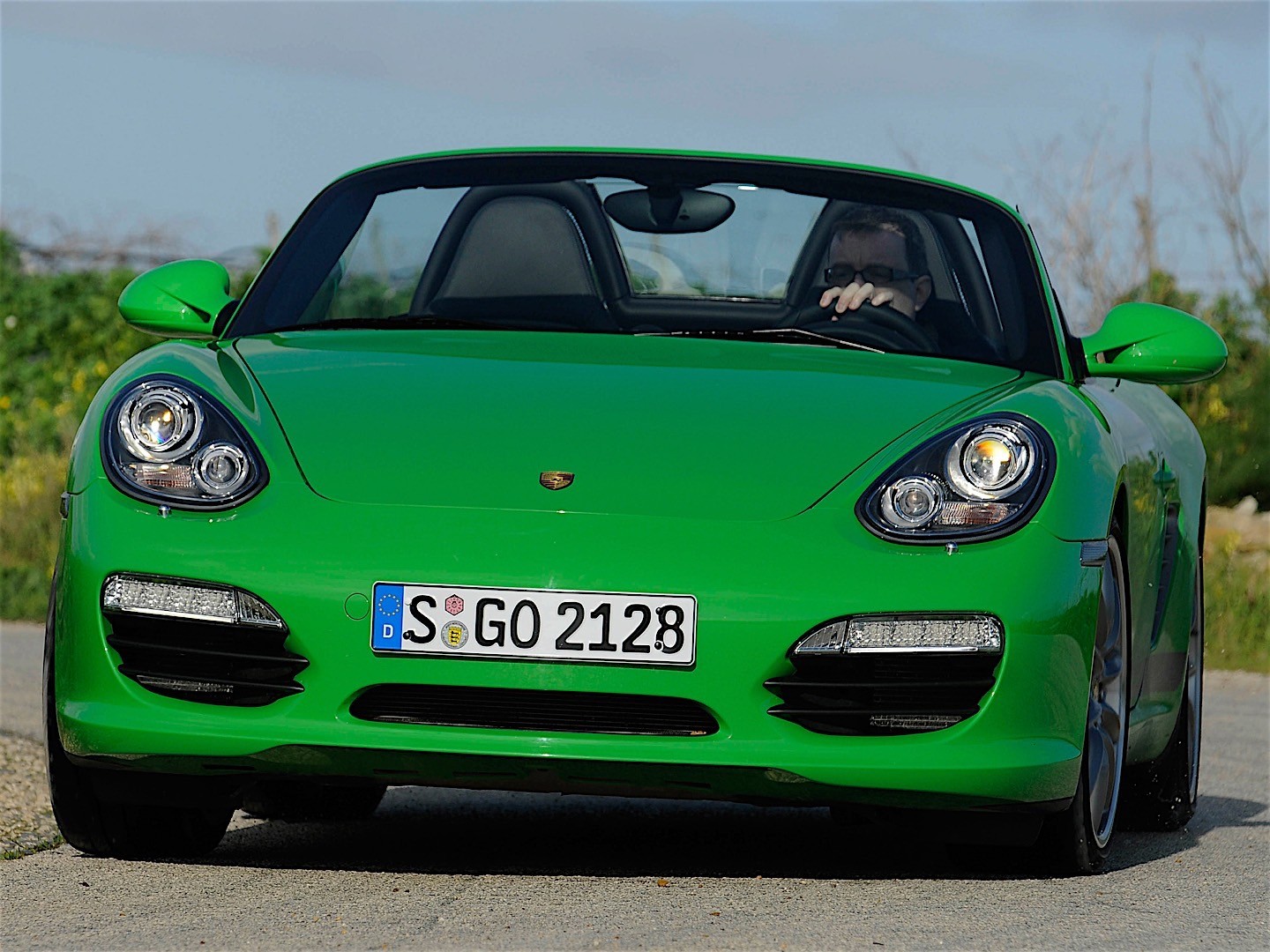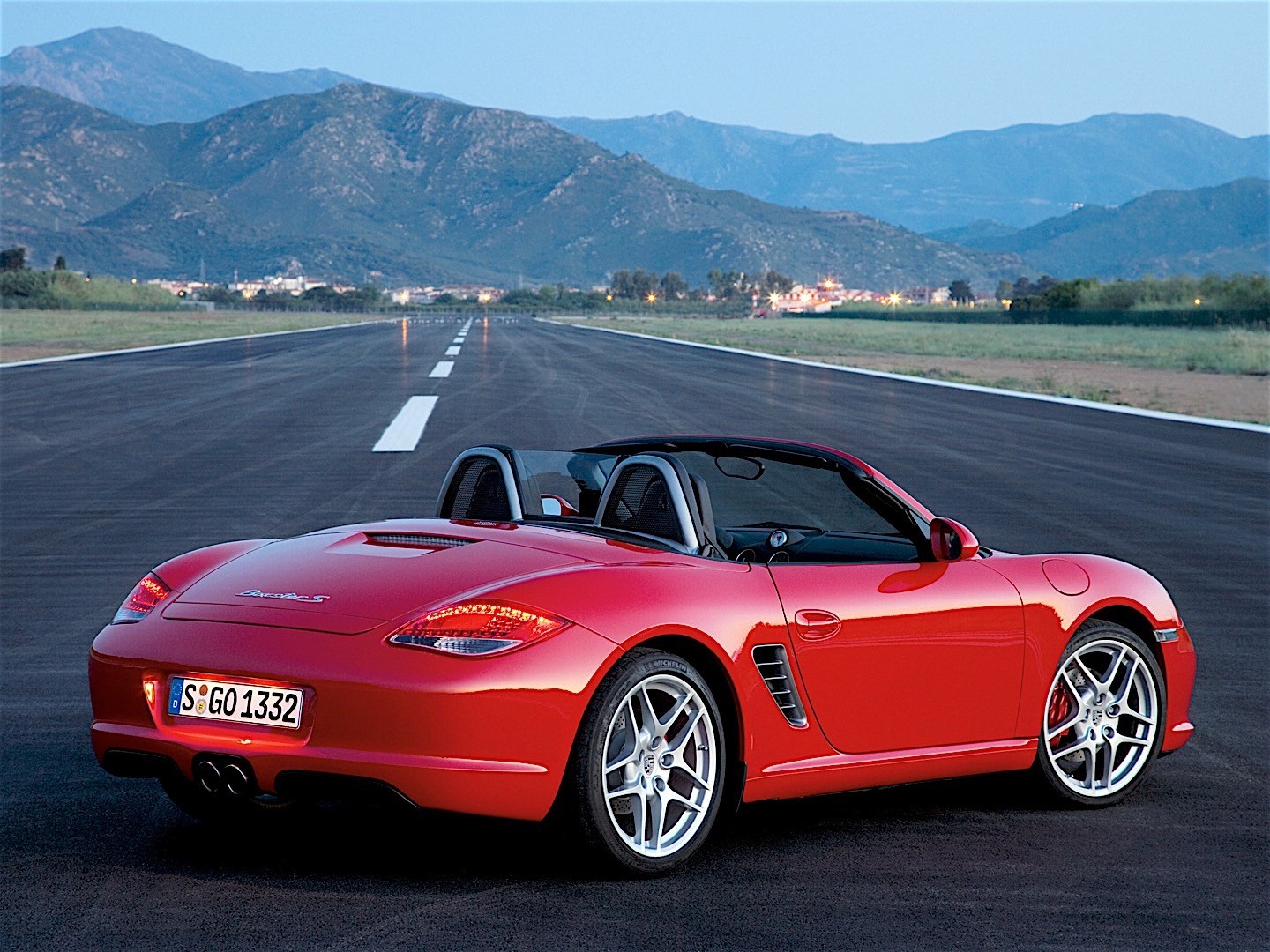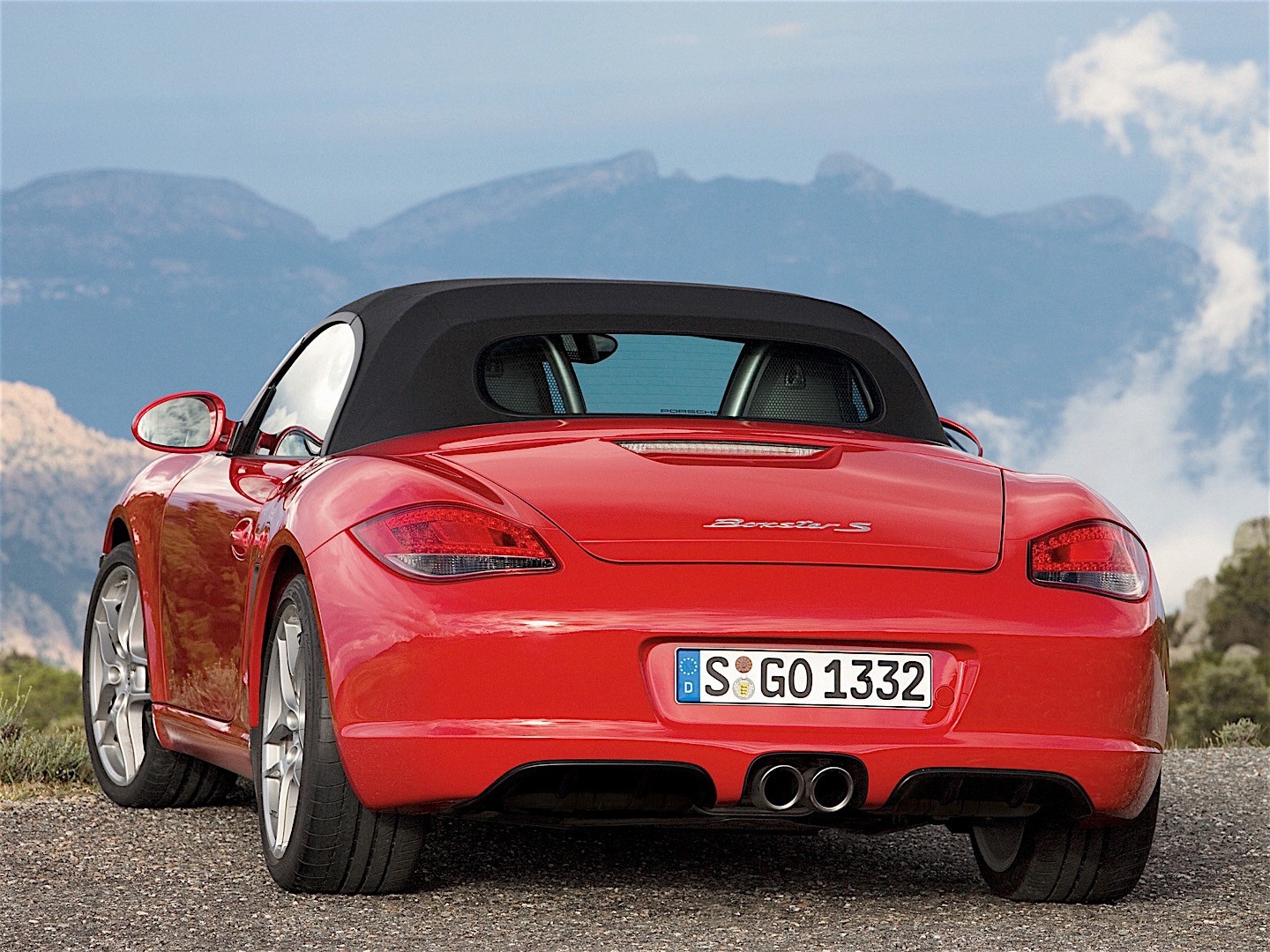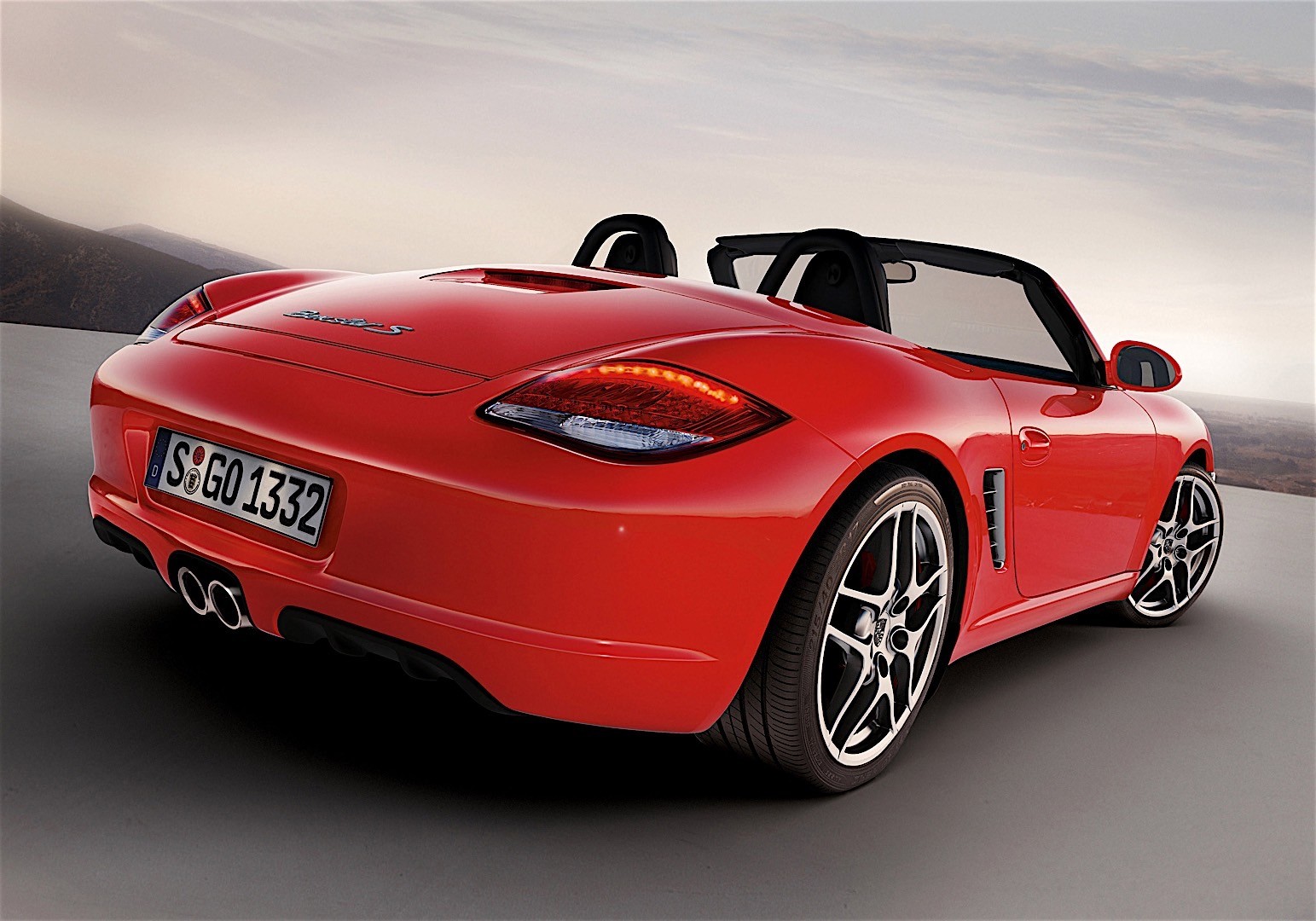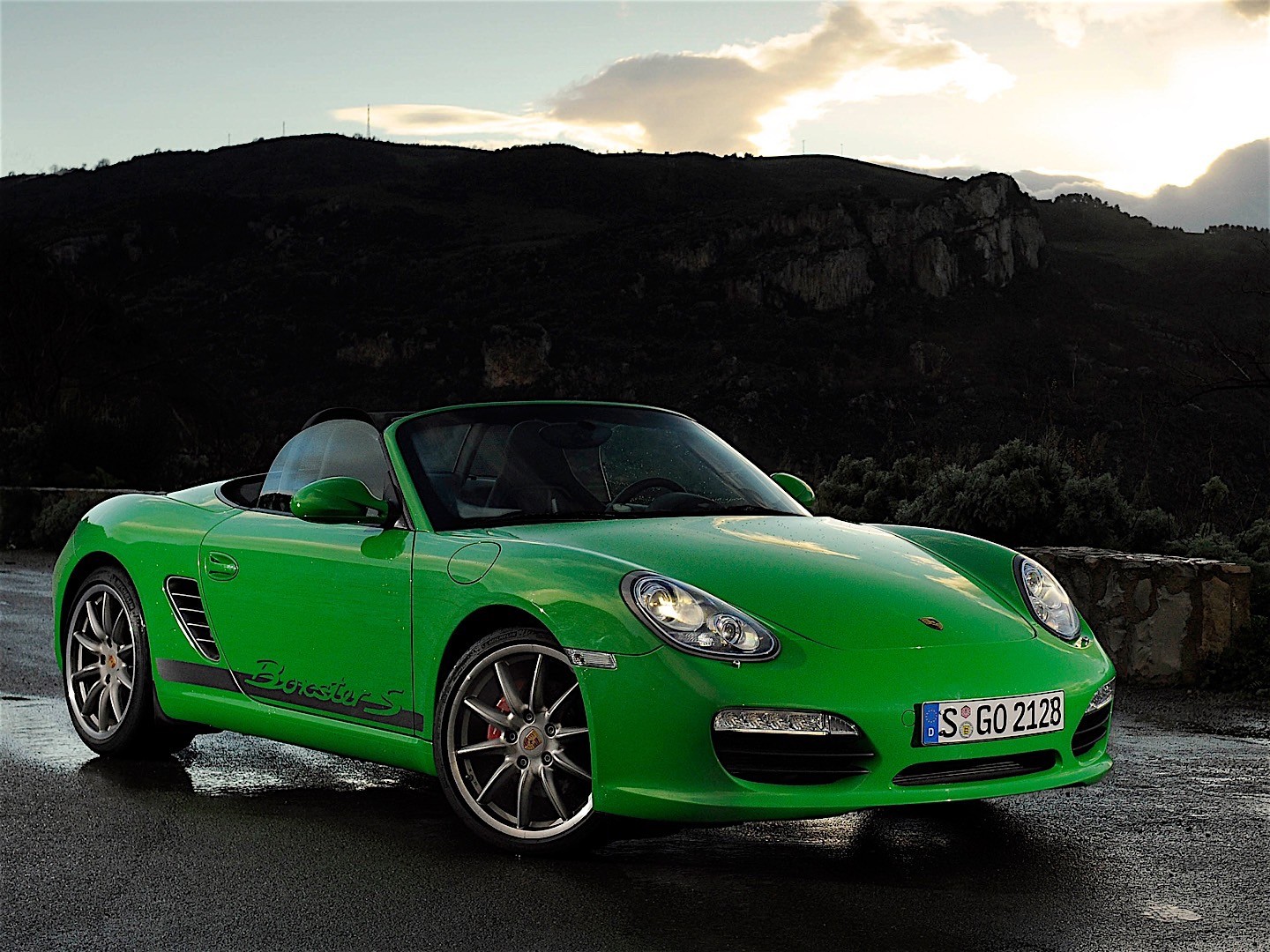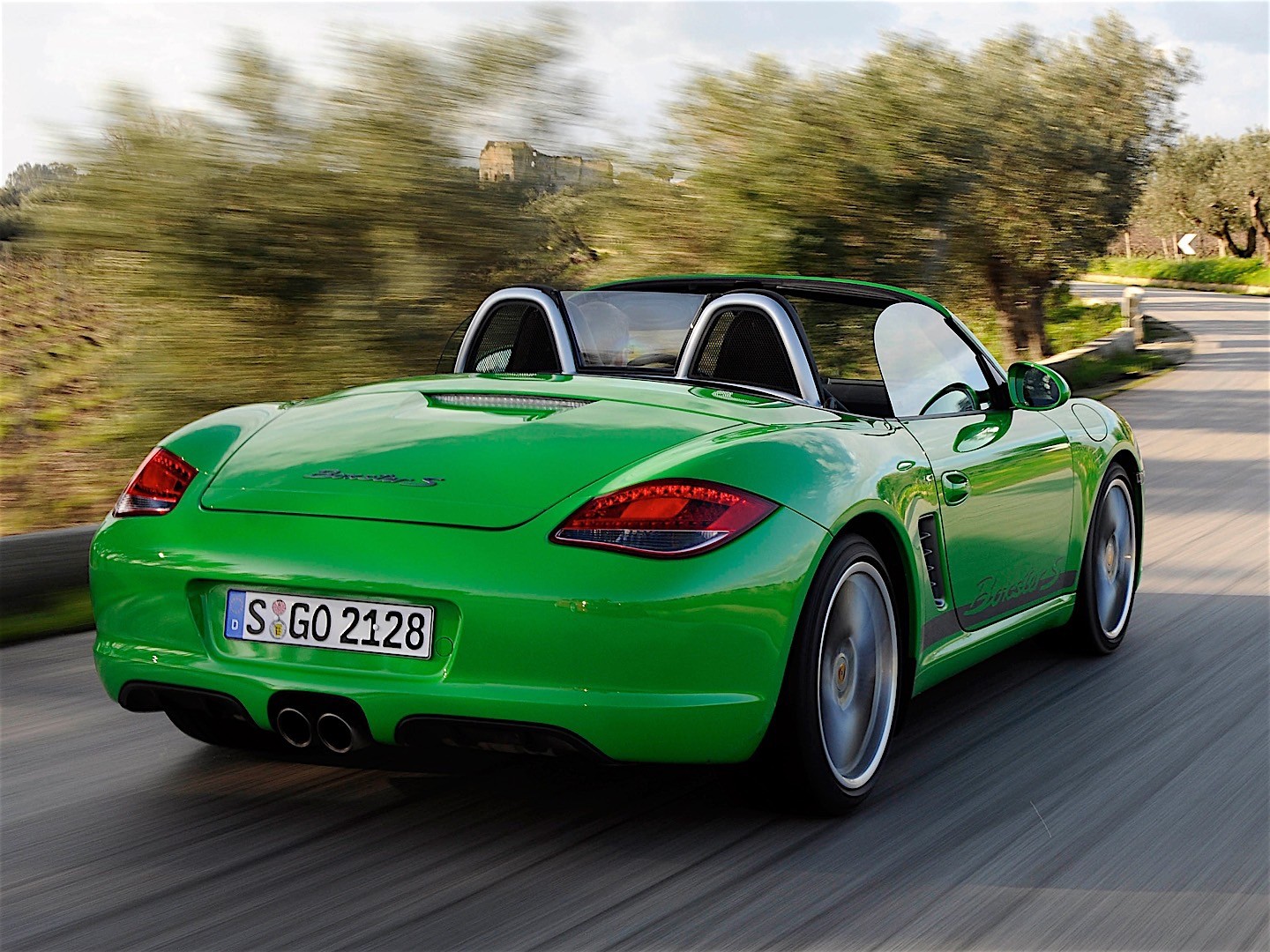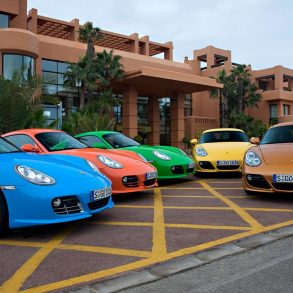(2009 – 2012) Porsche Boxster S – Ultimate Guide
The 2008 facelift of the Boxster S is powered by a new direct-injection 3.4-liter Boxer engine which develops more power than the earlier variant. The styling got a bit updated with some redesigned headlight casings, taillights, and bumpers, while the interior got new infotainment and more material/color combinations.
There’s a revised 6-speed manual as well as a new 7-speed PDK gearbox that further improves performance. For the vehicles equipped with Sport Chrono Package or Sport Chrono Package Plus, a launch-control program is available.
A limited Boxster S Black Edition was introduced in 2011, coming with 20 more hp, blacked-out interior, and exterior as well as standard anti-dazzle mirrors, automatic wipers, cruise control, climate control and more.
For better handling, the Boxster is fitted as standard with the PSM (Porsche Stability Management) and the optional PASM suspension. At the touch of a button, this system changes damper forces for sport or for comfort.
For more performance, the Boxster S is available with a limited-slip differential that can put more grip on the tarmac. For better lap-times, it is best to have this feature installed if the optional 235/40 ZR 18 tires at the front and 265/40 ZR 18 tires at the rear are installed. For better stopping power, the Boxster S has an optional carbon-ceramic disc brakes o 319 mm (12.51″) on the front and 299 mm (11.77″) on the rear.
Pictures
Press Release
The Porsche Boxster is continuing to expand its lead as the trendsetter in the two-seater open sports car segment. Already acknowledged as a lightweight athlete with lots of power on very little fuel, Porsche’s mid-engined roadster now entering its second generation is becoming an even greater performer on even less fuel than ever before.
The highlight of the new generation is the six-cylinder boxer engines developed as completely new power units from the ground up, displacing 2.9 liters in the Boxster and 3.4 liters in the Boxster S. Indeed, these engines belong to the same family as the particularly efficient power units introduced only recently in the 911 model series.
The new “basic” engine now develops maximum output of 255 bhp (188 kW) at 6,400 rpm, up 10 bhp over the previous model with 2.7 liters capacity. Featuring Direct Fuel Injection, the six-cylinder in the Boxster S churns out 15 bhp more than before, now offering 310 bhp (228 kW), again at 6,400 rpm.
Clearly, this gives both roadsters a truly outstanding power-to-weight ratio, each horsepower in the Boxster now required to move only 5.2 kilos or 11.5 lb, while on the Boxster S the power-to-weight ratio is even better at 4.4 kg/bhp or 9.7 lb.
For the driver this means maximum performance on minimum fuel, particularly with the likewise brand-new Porsche-Doppelkupplungsgetriebe or PDK for short. Featuring this unique double-clutch gearbox, the Boxster S accelerates to 100 km/h or 62 mph in 5.2 seconds, the “regular” Boxster with PDK completing the same exercise in just 5.8 seconds. At the same time these outstanding two-seaters are more fuel-efficient than ever before, consuming 8.9 liters in the Boxster (equal to 26.3 mpg US) and 9.2 liters (equal to 25.5 mpg US) in the S model, in each case according to the EU4 standard and with PDK transmission.
It almost goes without saying that both power plants fulfill the strict EU5 and ULEV emission standards.
Self-confident looks
The new Boxsters are understandably very self-confident and even proud in their appearance, the extra-large air intakes characterizing the superior look of both models and accentuating their superior performance. On the Boxster two of the crossbars integrated in each side on the outer air intakes are finished in body color, on the Porsche Boxster S they come in black.
The LED positioning lights and foglamps now in horizontal arrangement come above the side air intakes. The direction indicators, in turn, are integrated in the new halogen headlights which, through their two-tube look, are reminiscent of the legendary Carrera GT.
As an option both Boxsters are available with new bi-xenon headlamps with a daytime light function, dynamic curve lights, a headlight washing system and automatic headlight range control. The separate LED daytime driving lights take the place of the foglamps whose function is now performed by the bi-xenon headlamps optimized for perfect light spread and illumination to the side.
PDK: shifting gears more quickly, improving fuel economy by up to 16 per cent
Both Boxsters are now available for the first time with the Porsche-Doppelkupplungsgetriebe or double-clutch gearbox derived from motorsport and replacing the former Tiptronic S transmission. PDK comes with seven gears and is made up of two transmission units each connected to the drivetrain through its own clutch. One transmission unit comes with gears 1, 3, 5 and 7 as well as reverse gear, the other comes with gears 2, 4 and 6. Gears are shifted very fast, with supreme smoothness and without the slightest interruption of trac tion, the clutch on one transmission unit opening up and the clutch on the other transmission closing at exactly the same time for an ongoing flow of power.
This entire process takes place automatically in selector lever position D, while the driver is also able to shift gears manually via paddles on the steering wheel or with the selector lever in the middle. In each case the process of disengaging and engaging the clutch is fully automatic, without requiring any intervention on the part of the driver.
PDK improves not only motoring comfort, but also allows even better performance and greater fuel economy than on the manual gearbox models. As a result, the Porsche Boxster S, benefiting from the uninterrupted flow of power, accelerates to 100 km/h or 62 mph in 5.2 seconds, the Boxster completing the same exercise in 5.8 seconds.
On the Porsche Boxster S fuel consumption is down by no less than 16 per cent to 9.2 liters/100 kilometers or 25.5 mpg US versus the former model with Tiptronic S, thanks to the optimum shift points and transmission ratios offered by PDK. The “basic” model equipped with PDK even remains below the nine-liter mark, fuel consumption of just 8.9 liters/100 kilometers (equal to 26.3 mpg US) representing a decrease in fuel consumption by 11 per cent versus the former model.
Equipped with PDK, the new models accelerate to 100 km/h or 62 mph 0.2 seconds faster than before thanks to the new Launch Control with electronic power management ensuring optimum acceleration from a standstill.
Launch Control is activated by the Sport Plus button which, in conjunction with PDK, comes both on the optional Sports Chrono Package and on the likewise optional Sports Chrono Package Plus. The latter is available exclusively in combination with Porsche’s optional PCM Communication Management and offers both an additional performance indicator and an individual memory function.
The Sport Plus button also comes with a particularly sporting gearshift strategy for the PDK double-clutch gearbox ideally suited for the race track.
Yet a further feature on both equipment packages is the particularly sporting set-up of other vehicle systems available at the touch of a button – for example engine management, PSM Porsche Stability Management, and the optional PASM suspension.
The packages are clearly recognizable at first sight through the activation buttons in the center console and an analogue/digital stopwatch on the instrument panel masterminded through the lever on the steering column and enabling the driver, to mention just one example, to precisely record his lap times on the track.
Both models come as standard with a further improved six-speed manual gearbox. Another standard feature in both cases – with the manual gearbox and Porsche’s new PDK – is the Start-Off Assistant relieving the driver from the usual chores of everyday motoring and preventing the car from rolling forwards or backwards when setting off on a gradient by automatically holding the car in position and letting go of the brakes in a controlled process after the driver has released the brake pedal. Without having to pull the handbrake, the driver is therefore able to set off on a gradient smoothly and comfortably thanks to Porsche’s new Start-Off Assistant.
Suspension even more dynamic and comfortable than before
The exceptional driving pleasure offered by both models in the Boxster range is also a result of the wide track and the newly set-up suspension improving the cars’ driving dynamics to an even higher standard despite the enhancement of motoring comfort. One of the features contributing to the re-set suspension is the newly developed tyres offering a further improvement of performance together with greater driving comfort by reducing tire pressure on the rear wheels.
The Boxster now comes as standard on 17-inch wheels half an inch wider than before in order to take up the larger brake system of the Boxster S on the front axle. Tire dimensions remain unchanged at 205/55 ZR 17 up front and 235/50 ZR 17 on the rear wheels. The Boxster S, in turn, comes on18-inch rims running on 235/40 ZR 18 tires at the front and 265/40 ZR 18 tires at the rear.
In conjunction with 18- and 19-inch wheels, the new models in the Boxster range are also available with a limited-slip differential on the rear axle. Locking action in this case is 22 per cent under power and 27 per cent in overrun. The result is a significant improvement of both traction and stability providing a substantially higher level of performance on winding routes, particularly on the race track.
Yet a further advantage is the more stable load change behavior. And at the same time the mechanical limited-slip differential, through its particular function, interacts perfectly with the electronic ABD Automatic Brake Differential for optimum traction control, the locking action delaying the tendency of one wheel to spin on a road surface slippery only on one side.
Porsche Active Suspension Management or PASM for short is available as an option on both models. At the touch of a button PASM changes damper forces and thus offers the ideal combination of both a sporting and comfortable as well as a sporting and dynamic suspension, the latter proving its qualities particularly on the race track.
Superior brake system with optional ceramic brakes
Cross-drilled and inner-vented brake disks ensure excellent deceleration and stopping power on both models in the Boxster range. At the front brake energy is conveyed to the brake disks now measuring 318 mm or 12.51″ in diameter and 28 mm or 1.10″ across by fourpiston aluminum monobloc fixed calipers.
At the rear the Boxster comes with 20-millimeter (0.79″), the Boxster S with 24-millimeter (0.94″) thick brake disks, in each case measuring 299 millimeters or 11.77″ in diameter for optimum stopping power and again interacting with four-piston aluminum monobloc fixed calipers.
Porsche Ceramic Composite Brakes (PCCB) available as an option on the Boxster S open up a new dimension in brake technology and performance in the roadster segment. This very special package of ceramic disks measuring 350 millimeters or 13.78″ in diameter on all four wheels as well as special brake pads features yellow-painted six-piston aluminum fixed calipers at the front and four-piston aluminum fixed calipers at the rear, offering truly supreme and, in particular, consistent stopping power and deceleration and therefore ensuring very short stopping distances even under extreme conditions.
Comprehensive restraint system with head airbags
Featuring head airbags in an open car, the Boxster sets the standard also in terms of passive safety. The airbags protect the cars’ occupants in a side-on collision as an additional safety factor supplementing the side impact protection in the doors, by inflating out of the sills beneath the side windows within fractions of a second.
This effect is supplemented by thorax airbags inflated on the outer section of the seat backrests.
Together with the two full-size frontal airbags operating in two stages as well as belt latch tensioners and belt force limiters, the Porsche roadster offers a very high standard of allround passive safety.
Sophisticated interior with new PCM
Both the Boxster and the Boxster S come as standard with Porsche’s CDR-30 audio system featuring an easy-to-read five-inch monochromatic display. The CD player integrated in this system also plays music in the MP3 format.
Porsche’s new PCM Communication Management now even more efficient, versatile and a lot easier to use is available as an option, serving as the central control unit for all audio, communication and navigation features in the car.
The highlight of PCM is the new control monitor with its highly advanced touchscreen. Measuring 6.5 inches, this screen is significantly larger than the 5.8-inch unit on the former model. At the same time the number of control keys has been halved to just 16, again in the interest of extra convenience.
In conjunction with the optionally available universal audio interface, PCM is now also able to control external audio sources such as an iPod® or a USB stick.
Further options on the PCM unit are Porsche’s new voice entry and the electronic logbook.
Yet another new feature is the Porsche Sound Package Plus complete with a radio, CD player and seven loudspeakers available as an option, just like the BOSE® Surround Sound System with eleven loudspeakers and a seven-channel digital amplifier naturally geared to the car as well as various telephone connection options.
In combination with seat heating, the new Boxsters come as an option with seat ventilation on both the standard seats and the comfort seats in full or partial leather. Particularly in the warm season, active seat ventilation ensures a pleasantly comfortable and dry climate on the seat surface ventilated at exactly the right points where the occupant is in close touch with the seat.
The driver and passenger are able to activate seat ventilation together with the seat heating, reliably removing moisture on the surface and ensuring a pleasant temperature at the same time.
More Power on Less Fuel
The Porsche Boxster is continuing to build up its lead as the role model in the segment of open two-seater sports cars. Already a lightweight with lots of power and superior fuel efficiency, the second generation of Porsche’s mid-engined roadster is now even more athletic in its performance and more modest in its fuel consumption.
The highlight of the new model is the new six-cylinder boxer engines developed as completely new power units from the ground up, displacing 2.9 litres in the Boxster and 3.4 litres in the Boxster S.
These engines belong to the same family as the particularly efficient power units introduced only recently in the 911 model series. The new “basic” engine now develops 255 bhp (188 kW) at 6400 rpm, up by 10 horsepower over the previous model with its 2.7 litres.
Maximum torque is up by 17 Nm to 290 Nm or 214 lb-ft delivered consistently between 4400 and 6000 rpm.
Featuring Direct Fuel Injection (DFI), the six-cylinder in the Porsche Boxster S offers 15 bhp more than before, now developing 310 hp (228 kW) also at 6400 rpm. Maximum torque of 360 Nm or 265 lb-ft – 20 Newton-metres more than before – comes between 4400 and 5500 rpm from this unique 3.4-litre.
Given this kind of power, the balance of output and weight on both Porsche roadsters so crucial to a dynamic sports car is improving once again. With its unladen weight of just 1335 kg or 2944 lb quite outstanding for an open sports car in this class, the Boxster offers a powerto- weight ratio of 5.2 kg per horsepower.
Weighing 1355 kg or 2988 lb unladen, in turn, the Porsche Boxster S is even more dynamic with a power-to-weight ratio of just 4.4 kg.
In either case the driver benefits from maximum performance on minimum fuel, Porsche’s new roadsters achieving their most outstanding performance and fuel economy in combina tion with the new Porsche-Doppelkupplungsgetriebe (PDK), the Porsche Double-Clutch Gearbox.
Shifting gears very quickly without the slightest interruption of power, the Boxster S with PDK accelerates to 100 km/h in just 5.2 seconds, while the “basic” Boxster completes the same exercise in an equally impressive 5.8 seconds.
Thanks to the optimum gearshift points and gear ratios with PDK, the Boxster S offers 16 per cent better fuel economy than the previous model with Tiptronic S, reducing fuel consumption to a mere 9.2 litres/100 kilometres (EU4), equal to 30.7 mpg imp.
The “basic” model with PDK even remains below the nine-litre limit, average fuel consump tion of 8.9 litres/100 km or 31.7 mpg imp improving fuel economy by 11 per cent over the former model.
Equipped with the manual gearbox now featuring six gears as standard on both models, the Boxster S accelerates to 100 km/h in 5.3 seconds, the Boxster completing the same sprint in 5.9 seconds. And even with this manual gearbox, Porsche’s two-seaters consume even less fuel than before, with fuel consumption down to 9.2 litres/100 km (equal to 30.7 mpg imp) on the Boxster and 9.6 litres/100 km (equal to 29.4 mpg imp) on the S-model, in both cases to the EU4 standard.
Striking Appearance
The new roadsters come with their own unique profile standing out clearly from the Cayman. Seen from the front, the outer air intakes larger than on the former model clearly underline the self-confident appearance of the car as well as the superior performance of the new models. Two of the crossbars integrated on either side in the outer air intake scoops are finished in body colour on the Boxster and come in black on the Porsche Boxster S, adding a new graphic effect at the front to make Porsche’s new roadster quite unmistakable at very first sight.
LED positioning lights and foglamps now come in horizontal arrangement above the air intakes at the side. The direction indicators are integrated in the new halogen headlights reminiscent in their look of the Carrera GT.
A Lights Package featuring new bi-xenon headlights, dynamic bending lights, LED daytime driving lights, a headlight cleaning system and automatic headlight range control is available as an option on both versions of the Boxster. The daytime driving lights made up in each case of six LEDs positioned next to one another take the place of the foglamps whose function is now performed without any drawbacks by the bi-xenon headlights offering optimised side illumination and coverage for maximum clarity and safety.
Seen from the side, you will immediately notice the new series production wheels in their unique design. The Boxster comes on 17-inch wheels in open five-spoke design, the S-model boasts Porsche’s new 18-inch Boxster S II wheels with five sporting and dynamic double spokes.
Through their design, both production wheels offer an impressive view of the brake system and help to vent the brakes.
The double-arm exterior mirrors are likewise new in their design, offering even better visibility to the rear and fulfilling all future legal requirements. Optimised aerodynamics serves furthermore to keep the mirrors cleaner in wet weather.
Matching the new front section, Porsche’s designers have created a brand-new rear panel design on the Porsche roadster. The newly designed rear light clusters with all red lights in LED technology give the car particular character from behind. And at the same time the lights respond very quickly, serving to enhance the car’s active safety.
Tapering out to a sharp point at the outside, the rear light clusters are stylishly and elegantly integrated into the new rear end of the car, the LED graphics providing truly striking light design.
Equally striking diffuser inserts surrounding the newly designed tailpipes in the middle round off the new rear end at the bottom. The Boxster comes with a single tailpipe, the Boxster S boasts twin tailpipes in a special look reminiscent of the 911 GT3.
Six-Cylinders New from the Ground Up
The power units in the Boxster and Boxster S are entering the market as the latest repre sentatives of Porsche’s new generation of flat-six engines. Completely new from the ground up, the engines are lighter than before and have fewer individual components, while deve loping more power and performance and offering even greater efficiency than their predecessors.
On the Boxster the 2.9-litre replaces the former 2.7-litre power unit, the increase in engine size being accompanied by an increase in compression from 11.3 to 11.5, serving to boost maximum output to 255 bhp (188 kW).
The engine on the Porsche Boxster S comes with the same 3.4 litres capacity as before. But benefiting from Porsche’s new Direct Fuel Injection (DFI) and the compression ratio up from 11.1 to 12.5, the engine now offers maximum output of no less than 310 bhp or 228 hp.
The greater efficiency of the new power units results to a large extent from the consistent enhancement of fundamental features and characteristics: Lower weight, reduced internal friction and fewer moving masses help to give both six-cylinders more power on less fuel.
As a result, the new engines are about six kilos lighter than the former power units, a twopiece crankcase with integrated crankshaft bearings replacing the former four-piece block with its separate bearing supports. The big advantage, apart from lower weight, is the smaller number of individual components.
At the same time Porsche’s engineers have increased the thermal and mechanical robustness of the engine by changing the structure of the crankcase from an open- to a closeddeck configuration. The cylinder liners so far standing freely around the cylinder gasket are now connected with the block through a cast-in coverplate encompassing the coolant ducts, giving the cylinders even greater stability in their shape and structure.
A further advantage is the reduction of oil consumption and, thanks to the lower level of friction, a reduction of fuel consumption.
New engine mounts with additional crosswise stops and new mounting specifications serve additionally to enhance driving comfort and improve driving dynamics at the same time, with the engine integrated even more firmly into the car and thus reducing relative movement on the body itself.
The Boxster S: the First Boxster with Direct Fuel Injection
Introducing the 3.4-litre power unit featured in the new Boxster S, Porsche is hailing the advent of Direct Fuel Injection (DFI) in the mid-engined roadster segment. Porsche DFI operates on a homogeneous fuel/air mixture, spreading out air and fuel smoothly and consistently within the combustion chamber in the interest of optimum combustion at all times. So depending on engine load and speed, fuel is injected by DFI at a pressure of up to 120 bar directly into the combustion chamber.
The fundamental benefit is that contrary to conventional intake manifold injection, the fuel/air mixture is now formed directly in the combustion chamber itself. While in the case of indirect fuel injection fuel is partly atomised upfront of the closed intake valve, the advantage with Direct Fuel Injection is that fuel is not injected directly into the cylinders until the valve is open.
Positioned between the two intake valves, the injector is aimed directly at the two flows of air, thus avoiding the wall film loss inevitably suffered in the conventional process by fuel mist coming to rest on the walls of the intake manifold.
The air and fuel are therefore mixed even better within the cylinder, ensuring a clean and complete combustion process. The thermal energy required for evaporating the fuel within the combustion chamber is drawn from the combustion air and cooled down in the process. This reduces the cylinder charge volume and allows the induction of additional air through the open intake valve, again improving the cylinder charge.
A further benefit is that the lower temperature reduces the knock effect, allowing a higher compression ratio: Versus the former model, the compression ratio on the 3.4-litre is 12.5:1, serving again to enhance the thermal efficiency of the engine for more power on less fuel.
Direct Fuel Injection has a positive effect not only on the engine’s efficiency, but also on the characteristic features of the Boxster S power unit, as the driver will feel right away: With fuel being injected fractions of a second prior to combustion, the engine responds even more smoothly and spontaneously to even the slightest movement of the gas pedal.
Exhaust Emissions Meeting Even the Strictest Standards
Both power units already fulfil the upcoming emission standards to EU5 in Europe and the ULEV standard in the USA. To ensure this particular quality, the 2.9-litre features a secondary air pump helping to burn fuel in the exhaust emissions when starting the engine cold and thus warming up the catalytic converters more quickly to their regular operating temperature.
The 3.4-litre offers a comparable effect by means of the high-pressure stratified charge process with the catalysts being heated up immediately thereafter. In the process dual fuel injection increases the temperature of the exhaust gas to heat up the catalysts as quickly as possible. The fuel/air mixture is ignited at a very late point, again serving to increase the temperature of the exhaust emissions and reduce the volume of emissions during the startup phase.
Ultimately the newly developed exhaust system with two pre-catalysts integrated in the mani folds near the engine as well as two main catalysts helps to clean the exhaust gases as quickly and completely as possible.
VarioCam Plus for Superior Power on Less Fuel
Like their predecessors, the new power units feature Porsche’s proven VarioCam Plus camshaft adjustment with variable control timing on the intake side and valve lift control. These operations are performed by hydraulically controlled cup tappets on the intake side of the engine masterminded by two cams varying in size on the intake camshaft.
The big advantage of VarioCam Plus is the combination of optimum output and torque with enhanced fuel economy, emission management and running smoothness. In combination with Porsche’s new Direct Fuel Injection this offers an ideal symbiosis increasing engine output and torque and reducing fuel consumption at the same time.
To further enhance the spontaneous and direct response of the engine, its efficiency and fast-revving running characteristics, the engineers in Weissach have re-designed the entire valve train. In their diameter, the shift tappets for the intake valves are down from 33 to 31 millimetres (1.22 – 1.20″), the tappets on the exhaust valves from 33 to 28 millimetres (1.22 – 1.10″).
Through these smaller dimensions and the lower weight of the fast-moving tappets, mass inertia is reduced accordingly and engine speed is increased. As a result, maximum permissible engine speed is now 7500 rpm, with both power units developing their maximum output at 6400 rpm.
On-Demand Oil Pump and Separate Cooling Pump
A further step to enhance the efficiency of Porsche’s new engines was to optimise the oil supply and extraction system, with the engineers focusing, first, on a secure oil supply also under even higher lateral and longitudinal acceleration. The second point was to further reduce frictional and drive losses within the system.
To reach these objectives, the oil circuit on the new engines follows the principle of integrated dry sump lubrication, made up of an oil pump with four intake stages and a pressure stage now fully controlled for the first time.
Engine management adjusts the flow of oil to current requirements at all times, thus reducing the power required to run the oil pump and, accordingly, the load acting on the engine. Clearly, this also helps to reduce fuel consumption.
For the first time the coolant pump on Porsche’s new Boxer engines is fitted outside of the crankcase, allowing flexible adjustment of pump dimensions and reducing the cost of service and repair when necessary. As a result, the maximum volume flow developed by the new coolant pump in accordance with the higher power of the engine and to ensure an adequate engine cooling effect at all times is up by approximately 20 per cent.
New, Variable Intake System
Both power units come with a new intake system incorporating the resonance and distri butor pipe between the right- and left-hand intake distributor. One of the new features is the newly designed centre section between the right- and left-hand intake distributor. Originally fitted as separate units, the resonance and distributor pipes have now been integrated to form one common component. Reflecting the shape of the centre section now oval in its form, the resonance and distributor pipe flap are semi-oval in their geometry.
The switching resonance flap serves to adjust air oscillation in the intake system to the respective speed of the engine, ensuring high torque at low speeds, an even smoother torque curve, as well as high maximum output. The two-chamber distributor tube with its switching flap likewise improves engine torque at low engine speeds.
The intake distributors on the two rows of cylinders are tailored in their dimensions to the specific characteristics of the two power units, thus coming in different geometry. Another new feature is the re-configured resonance chamber in the upper section of the intake distributor. This function new on the “basic” engine serves to dampen acoustically unpleasant resonance noise at high engine speeds. Together with the newly developed exhaust system, the sound pattern of the engine has therefore been re-composed, now offering even greater brilliance and an even more dynamic touch.
Accelerating Faster, Saving Fuel: the Porsche-Doppelkupplungsgetriebe (PDK)
The two new roadsters are available as an option for the first time with Porsche’s Doppelkupplungsgetriebe or PDK for short, the Double-Clutch Gearbox with seven gears replacing the former Tiptronic S.
In principle PDK is made up of one manual gearbox separated into two individual transmission units and a hydraulic control unit. The “heart” of the transmission is formed by two interacting multiple-plate clutches running in an oil bath and hydraulically operated on one joint shaft.
One clutch is for the first gearbox unit incorporating the uneven gears and the reverse gear, the other clutch is for the second gearbox unit comprising the even gears.
Through a number of pressure valves, the hydraulic control unit masterminds both the clutches and the shift cylinders activating the desired transmission ratio. The gears are shifted very fast, without the slightest jolt, and with no interruption of power or traction, the clutch on one gearbox unit opening up and the other clutch closing at the same time.
In selector lever position D this entire process takes place fully automatically, with maximum comfort and smoothness. Pressing the paddles on the steering wheel or simply tipping the selector lever, the driver may however also shift gears manually.
In either case the process of engaging and disengaging the clutch does not require any action on the part of the driver.
The big advantage is the gearshift up to 60 per cent faster than on a manual and converter automatic transmission, since the gears are already in mesh when the driver shifts from one gear to another. A further advantage is the reduction of weight on PDK, which, despite the addition of two further gears, is about 10 kg or 22 lb lighter than the former Tiptronic S transmission.
Porsche’s Doppelkupplungsgetriebe comes with seven forward gears and one reverse gear. Gears 1-6 feature a sporting transmission ratio, with the two models reaching top speed in sixth gear. With its long transmission ratio, seventh gear serves to provide an overdrive or economy function.
Shifting Gears on the Selector Lever or Directly on the Steering Wheel
The driver is able to operate the Doppelkupplungsgetriebe the same way as Tiptronic S in the past: Either by means of paddles on the newly designed PDK steering wheel or through the likewise redesigned selector lever in the centre console.
The steering wheel in its sporting three-spoke design comes with two shift paddles in particularly ergonomic arrangement. Pressing the right- or left-hand paddle to the front, the driver shifts up, pulling the paddles towards him from behind, he shifts down.
The PDK control display in the instrument cluster is likewise based on the proven Tiptronic S concept enhanced to an even higher standard and supplemented by an easy-to-read numerical indicator showing the driver which gear is currently in mesh (1-7). The driving program (P, R, N, D and M) currently in use, on the other hand, is presented by red LEDs next to the gearshift pattern.
Driving in Dynamic Style: the Sports Chrono Package and Sports Chrono Package Plus
In conjunction with the CDR-30 radio featured as standard, Porsche offers the Sports Chrono Package as a particular feature. And in combination with optional Porsche Communication Management (PCM), the driver also has the choice of the optional Sports Chrono Package Plus.
As before, both packages come with an analogue stopwatch on the instrument panel and a sports mode for the engine also serving to activate Porsche Stability Management (PSM) as well as Porsche Active Suspension Management (PASM), where fitted, via the Sports Button. In combination with Porsche Communication Management (PCM), both models also come with a performance display in the instrument cluster and an individual memory.
A brand-new feature on both packages is the additional Sports Plus function on cars fitted with the Porsche-Doppelkupplungsgetriebe. Pressing the additional Sports Plus button, the driver is able to choose an uncompromising, highly dynamic gearshift program for optimum performance on the race track. A further feature offered by this program is Porsche Launch Control for optimum acceleration from a standstill: To set off like in motorsport, all the driver has to do is press down the brake pedal with his left foot and push the gas pedal all the way down with his right foot (kick-down).
This will rev up the engine to 6500 rpm. Then, once the driver takes his foot off the brake pedal, the car will set off with maximum acceleration, both roadsters thus reaching 100 km/h another 0.2 seconds faster, the Boxster S in 5.0, the Boxster in 5.6 seconds.
New: Six-Speed Manual Gearbox on Both Models
Both new roadsters come as standard with a manual six-speed gearbox. Based on the gearbox in the former models, the new transmission unit has been modified in its geometric mounting points and power uptake to the new engines. Now the “basic” Boxster also comes as standard with the six-speed manual gearbox replacing the former five-speed unit.
Porsche offers drivers of the Boxster and Boxster S with a manual gearbox important help in reducing fuel consumption by means of the gearshift point indicator housed in the rev counter as a triangle to the right of the digital speedometer.
Depending on the gear in mesh, engine speed and the position of the gas pedal, the gearshift point indicator clearly tells the driver when to shift up, the instrument flashing on for the driver to shift up to the next higher gear in the interest of enhanced fuel economy. Clearly, the driver receives this recommendation only if the gear suggested is appropriate for maintaining the speed or process of acceleration chosen by the driver in advance.
Limited-Slip Differential as an Option
A limited-slip differential on the rear wheels is available for the new Boxsters in conjunction with both 18- and 19-inch rims. Locking action is 22 per cent under power and 27 per cent in overrun, thus significantly improving both traction and stability for significantly enhanced performance on winding roads, particularly on the track.
A further advantage is the even more stable load change behaviour. And last but certainly not least, the mechanical limited-slip differential, through its particular function, reduces electronic brake intervention (ABD) by PSM Porsche Stability Management, with the locking action reducing the tendency of a wheel to spin when running on a slippery surface at one side of the car.
Start-Off Assistant also with the Manual Gearbox
Both with the manual gearbox and Porsche’s new PDK, the two-seater Boxster now comes as standard with a Start-Off Assistant offering the driver even easier and smoother control in everyday motoring and preventing the car from rolling forwards or backwards for about two seconds when setting off on a gradient by automatically holding and subsequently releasing the brakes after the driver lets go of the brake pedal.
The Start-Off Assistant therefore allows the driver to set off smoothly and comfortably on an uphill or downhill gradient without having to use the handbrake.
Enhanced Driving Dynamics and Improved Comfort
The wide track and the newly aligned suspension improving driving dynamics to an even higher standard and offering extra comfort in the same process make a significant contribution to the unusual pleasure of driving the Boxster. Indeed, the combination of wide track with wide wheels and tyres, together with the mid-engine, allows a very dynamic style of motoring with enhanced driving stability and lateral acceleration. Body roll and dive are reduced to a minimum, with the long wheelbase of the Roadster ensuring additional stability when driving in a straight line.
The front suspension is made up of a spring strut axle with wheel-guiding spring struts and aluminium longitudinal and track control arms, a concept combining very precise wheel guidance with a high standard of roll comfort.
An additional rebound stop spring in the front axle damper strut reduces the roll angle, keeping the Porsche roadster even more stable even under high lateral acceleration. The rear spring struts are now mounted in special spring supports additionally damping the transmission of bumps, noise and vibration to the body of the car and again enhancing roll comfort.
Upgraded Tyres with an Environmentally Friendly Rubber Compound
The upgraded generation of tyres interacts perfectly with the re-aligned suspension, combining even greater performance with enhanced motoring comfort by reducing tyre pressure on the rear wheels. Hence, tyre pressure at the rear on all 17- and 18-inch wheels is now just 2.1 bar, as opposed to 2.5 bar in the past. Tyre pressure at the rear in the 19-inch wheels, in turn, is down from 2.5 to 2.3 bar.
The tyres themselves are made of PAH (polycyclic aromatic hydrocarbons)-free rubber compounds containing even less harmful substances and actually not required by law until the year 2010.
The Boxster comes as standard on 17-inch wheels half an inch wider than before in order to accommodate the larger brakes of the Boxster S at the front. Tyre dimensions remain unchanged at 205/55 ZR 17 up front and 235/50 ZR 17 on the rear wheels.
The Porsche Boxster S runs on 18-inch wheels with 235/40 ZR 18 tyres at the front and 265/40 ZR 18 at the rear. To help the driver in the event of a breakdown, both models come as standard with a tyre sealant and an electrical compressor, omission of an emergency wheel and car jack reducing the weight of the car by 10 kilos or 22 lb.
Optional: Enhanced TPC Tyre Pressure Control
Porsche’s new, even faster TPC Tyre Pressure Control is available as an option on the new roadsters, offering even more safety by warning the driver of tyre damage following a possible loss of pressure.
A further advantage is that the system enables the driver to check out and control air pressure most conveniently, quickly determining whether tyre pressure is too low and thus avoiding excessive tyre wear and fuel consumption.
With TPC being initialised once the driver opens the door, the system is able to start checking tyre pressure immediately when the driver turns the key in the ignition, thus informing the driver of the appropriate pressure readings within the instrument cluster in just a few seconds.
Even after changing a wheel, in which case Tyre Pressure Control has to register and communicate with the electronic control units inside the tyre, the driver is informed of the new readings within three minutes at the very most.
Yet a further advantage is that with the new system tyre pressure is still monitored appropriately on the other wheels even after complete failure of one or two electronic wheel control units.
Active PASM Suspension as an Option
Porsche Active Suspension Management or PASM for short is available as an option on both roadsters. At the touch of a button, PASM changes the damper setting, thus combining a sporting and comfortable set-up with a more dynamic setting particularly suitable for driving the car on the race track.
Compared with the standard suspension, PASM suspension lowers the entire body of the car by 10 millimetres or almost 0.4″. And now being enhanced to an even higher standard, the PASM suspension offers even greater smoothness and suspension comfort without in any way imopairing the car’s driving dynamics.
With Porsche Active Suspension Management the driver is able to choose from two suspension programs simply by pressing a button on the centre console. Then, depending on his choice, a damper symbol will come on in the display of the instrument cluster, specifying the setting “PASM Normal” or “PASM Sport”.
The Normal setting offers an even more comfortable basic set-up of the dampers automatically changing to an increasingly sporting mode as soon as the driver switches over to a more dynamic style of motoring. This gives the occupants significantly greater motoring comfort particularly on long distances, with PASM absorbing minor and medium bumps on the road even more smoothly than the standard suspension.
The Sport setting, in turn, activates harder damper control maps for a very agile and sporting style of motoring. This gives the driver all the qualities of a sports suspension with body movement reduced even further for faster lap times, for example on the race track.
The PASM system is made up of adaptive dampers with continuously variable damper forces, two accelerometers to determine vertical movement of the car’s body, and the PASM control unit. The latter sets the signals for the two accelerometers fitted on the damper domes front right and rear left as a function of lateral acceleration, the steering angle, road speed, brake pressure and engine torque.
Taking these figures provided by the CAN bus, the system determines the optimum damper control map in each situation, setting the appropriate damper hardness separately on each wheel.
Rack-and-Pinion Steering with Reduced Steering Force
Modifying the valve control map on the steering transmission, Porsche’s engineers have reduced steering forces versus the former model, making the Boxster even more agile and spontaneous in its steering behaviour and facilitating the process of parking the car.
As in the past, hydraulically boosted rack-and-pinion steering with variable steering transmission ratios conveys the driver’s steering commands to the wheels. The result, again, is outstanding agility on winding roads combined with excellent driving stability at very high speeds.
The steering transmission ratio is larger around the centrepoint, that is with a small steering angle, giving Porsche’s roadsters very calm and smooth driving qualities particularly at high speeds. Then, with a steering lock of more than 30°, the steering transmission angle becomes increasingly direct for significantly enhanced agility on winding roads and improved handling, for example when turning to the left or right, in tight bends or when parking.
In all, the steering turns 2 ½ times from lock to lock.
Superior Brake System with Optional Ceramic Brakes
Cross-drilled, inner-vented brake discs featured as standard on both models ensure excellent stopping power at all times. Up front, brake energy from the four-piston aluminium monobloc fixed callipers is conveyed to the inner-vented brake discs now measuring 318 milli metres/12.52″ in diameter and 28 millimetres/1.10″ across on both models.
On the rear axle of the Boxster 20-millimetre (0.79″) and on the S-model 24-millimetre (0.94″)-thick brake discs likewise held by four piston aluminium monobloc fixed callipers and measuring 299 millimetres or 11.77″ in diameter also ensure optimum stopping power at all times.
The brakes are cooled efficiently by special brake vents incorporating air ducts at the front and additional brake air spoilers on the front axle. The overall result is even greater brake performance and further improvement of the brakes in their lasting behaviour absolutely free of fading.
Available as an option, Porsche Ceramic Composite Brakes (PCCB) open up a new dimension of stopping power in the roadster class on the Boxster S. This package of ceramic discs measuring 350 millimetres or 13.78″ in diameter on all four wheels and incorporating special brake linings, interacting with yellow-painted six-piston aluminium fixed callipers on the front axle and four-piston aluminium fixed callipers at the rear, ensures high and, in particular, consistent stopping power at all times for very short stopping distance even in extreme conditions.
Applying the Brakes Even More Safely with Porsche’s New PSM
Featured as standard in Porsche’s new roadsters, the latest version of PSM Porsche Stability Management offers a supreme level of active safety. PSM comprises the ABS anti-lock brakes, ASR traction control, MSR engine drag force control, the ABD automatic brake differential, as well as the latest functions, Pre-Filling the Brake System and the Brake Assistant.
The brake system pre-filling function enhances the car’s brake standby performance and helps to shorten stopping distances in an emergency. Whenever the driver lets go of the gas pedal very quickly – which is typical of an upcoming emergency braking manoeuvre – the PSM hydraulic unit builds up pressure in the wheel brakes before the driver even presses down the brake pedal. This moves the brake pads slightly towards the brake discs, significantly improving brake response and shortening the car’s stopping distance when necessary.
The Brake Assistant likewise serves to shorten stopping distances, building up additional hydraulic brake power in an emergency over and above the brake servo effect of the underpressure brake booster.
When recognising an emergency braking manoeuvre – for example with the driver pressing down the brake pedal very fast and hard – the PSM control unit actively builds up the brake pressure required for maximum deceleration.
To avoid unwanted all-out application of the brakes under sporting driving conditions, the Brake Assistant and the additional brake servo function are deactivated whenever the driver switches off PSM Porsche Stability Management or presses the Sports Button on the optional Sports Chrono Package.
In critical situations close to the limit PSM intervenes through selective application of the brakes in order to stabilise the car. Hence, the system offers a very high standard of active safety with agility typical of Porsche and, as a result, a high standard of driving pleasure.
To ensure agile driving behaviour in tight bends, PSM intentionally cuts in very late at low speeds of up to about 70 km/h or 50 mph. A further point is that the driver is able to switch off PSM whenever he wishes, with the system only being activated again upon application of the brakes – and even then PSM is only reactivated when the driver presses down the brake pedal really hard, exceeding the ABS control threshold at least on one front wheel.
This gives the sports-minded driver even greater freedom in his style of motoring, since PSM does not intervene when applying the brakes lightly and the driver is able to brake the car into a bend in more neutral style.
Stable, Safe, Sophisticated
In terms of torsional stiffness and safety, the body of the Porsche Boxster is among the best in its class. The bulkhead at the front end, for example, is made of particularly strong and sturdy steel, the longitudinal arms front and rear are constructed as tailored blanks. These are components welded together by laser from fine panels varying in thickness and in the type of steel used.
This kind of material composition and structure helps to reduce the weight of the car and specifically define the appropriate crash and deformation areas.
The so-called “upper load path” is particularly important on a car without a fixed roof in reinforcing the passenger cell in a head-on or offset collision. The upper load path diverts forces acting on the body in a crash very effectively on the Boxster from the front of a car through the doors to the rear.
To provide this effect, the doors are reinforced at the top by an additional steel profile plate and come to rest on a stable side structure in the event of a collision. A support tube made of high-strength steel and connected to the crossbar and A-pillars serves to further strengthen the passenger cell particularly in an offset collision.
At the same time Porsche’s engineers working on the Boxster have saved weight wherever possible, without making concessions in terms of stiffness and safety. Hence, the luggage compartment lid on the Boxster comes in an aluminium shell structure saving six kilos at the front and three kilos at the rear versus a conventional steel plate lid.
With their reinforced A-pillars and rollbars the Boxster and the Boxster S are perfectly prepared for a rollover. The rollbar is made of a special stainless-steel alloy able to meet the most demanding stiffness and stability requirements. It is manufactured in an internal highpressure moulding process with the steel tube placed in a negative mould and forced into its desired shape by water pressure, a process which hardly impairs the strength of the steel material.
Head Airbags: the Porsche Boxster – a Pioneer in Passive Safety
The Porsche Boxster was the first roadster with head airbags in an open car, setting new standards in passive safety. The airbags protect the occupants in a side-on collision over and above the side impact protectors in the doors by instantaneously inflating out of the door linings beneath the side windows.
Thorax airbags are inflated in addition in the outer section of the seat backrests, again in the interest of extra safety.
Together with the two full-size frontal airbags inflating in two stages as well as the belt latch tensioners and belt force limiters, the Porsche Boxster thus offers a very high standard of all-round passive safety.
Electrical Roof Featured as Standard, Wind Deflector and Hardtop as an Option
The folding roof so typical of a classic roadster already has a great tradition on the Porsche Boxster and offers significant benefits over a retractable hardtop crucial to a Porsche sports car with all its qualities: The soft top is lighter, lowers the car’s centre of gravity, and reduces the car’s roll angle in bends. At the same time it takes up less space and offers the occupants a seating position simply ideal for enjoying the thrill of open-air motoring even more intensely.
The Porsche Boxster comes with a particularly light roof structure made of magnesium, with only the tightening brackets and centre struts around the corners and the main support made of aluminium.
The roof may be opened and closed while driving at a speed of up to approximately 50 km/h or 30 mph.
A three-piece wind deflector made of plexiglass is available as an option, as is a hardtop coming as special equipment. Weighing only about 23 kg or 51 lb, the aluminium hardtop incorporates a heated rear window and is easy to fit in position and remove from the car.
Sophisticated Interior with New PCM
Again in typical Porsche style, the interior and equipment of the Boxster and Boxster S combine straightforward function with a sophisticated ambience. Both the Boxster and Boxster S come as standard with Porsche’s new CDR-30 audio system featuring an easy-to-read fiveinch monochromatic display. The integrated CD player, finally, is also able to play music in the MP3 format.
Porsche’s new PCM Communication Management now even more efficient, versatile and a lot easier to use is available as an option. PCM serves as the central control unit for all audio, communication and navigation features. Its main component is the new touchscreen monitor measuring 6.5 inches as opposed to 5.8 inches on the former model. And again in comparison with the former monitor, the number of control keys has been halved to just 16.
In conjunction with the universal audio interface available as an option, PCM now also allows the user to control and mastermind external audio sources such as an iPod® or a USB stick. Instead of the single-CD/DVD player featured as standard, PCM comes as an option with a six-CD/DVD player within easy and convenient reach of the driver and supporting the same formats as the single-CD/DVD unit.
Given its huge capacity, the changer is able to offer about 25,000 minutes of music through music DVDs.
Likewise available as an option, the TV tuner is able to receive uncoded analogue and digital DVB-T television signals. And last but not least, the PCM navigation module now comes with an integrated 40 GB hard disc comprising all the navigation data.
Further PCM options available from Porsche are the new voice entry available in conjunction with the navigation module and the electronic logbook. Then there is also the optional Porsche Sound Package Plus complete with a radio, CD player and seven loudspeakers, BOSE® Surround Sound with 11 loudspeakers and a seven-channel digital amplifier tailored to the specific geometry of the car, as well as various telephone options.
Optional: Heated Seats with Seat Ventilation for the First Time
Maintaining a healthy and comfortable micro-climate between the occupant and the surface of the seats is particularly important, since no other component in the car remains in direct contact with the occupants as long as the seats.
Precisely this is why Porsche has developed a special ventilation system for the seats now available for the first time also in the Boxster. This seat ventilation system comes in combination with seat heating on the standard seats and on the comfort seats with full or partial leather, offering a comfortable and dry climate around the seat surface particularly in the warm season.
To switch on seat ventilation, all the driver or passenger have to do is press a button in the centre console, initially activating the highest of three comfort stages, with three blue LEDs presenting the level of ventilation currently activated.
This level of ventilation remains active until the driver or passenger switch to another level. The only exception is that the system switches off automatically at a seat surface temperature of less than 15° C or 59° F in order to avoid undercooling.
The seat surface is ventilated specifically at those points where the occupant is in permanent contact with the seat, the venting points being clearly shown by the characteristic perforation of the seat upholstery.
The ventilation effect is provided by a fan in the seat and the backrest absorbing perspiration humidity between the occupant and the surface of the seat through the perforated seat and backrest centrepiece.
Air flows through a special air guide tissue and is conveyed through hoses beneath and, respectively, behind the seat. This rapidly cools down the seat surfaces heated, for example, by the sun, preventing the occupants from sweating while on the road.
Even when operating in their highest stage, the two fans are so quiet that they will hardly be noticed while driving. And last but not least, the seat ventilation may also be operated in conjunction with seat heating, serving to consistently remove humidity from the seat surface and maintaining a pleasant temperature at the same time.
Specifications Porsche Boxster S
Capacity: 3436 cc
Bore: 97.0 mm (3.81″)
Stroke: 77.5 mm (3.05″)
Compression Ratio: 12.5:1
Engine Output: 228 kW (310 bhp) at 6400 rpm
Max Torque: 360 Nm (265 lb-ft) at 5500 rpm
Output per Liter: 66.4 kW/90.2 bhp
Max Engine Speed: 7500 rpm
Fuel Grade: Premium plus
Dimensions
Length: 4342 mm (170.9″)
Width: 1801 mm (70.9″)
Height: 1294 mm (50.9″)
Wheelbase: 2415 mm (95.1″)
Track
front: 1486 mm (58.5″)
rear: 1528 mm (60.2″)
Luggage compartment capacity, overall, to VDA
front: 150 liters (5.25 cu ft)
rear: 130 liters (4.55 cu ft)
Fuel tank: 65 liters (17.2 imp gal)
Unladen weight, DIN: 1355 kg (2988 lb)
Max permissible weight: 1645 kg (3627 lb)
Performance
Top speed: 274 km/h (170 mph)
0-100 km/h: 5.3 s
0-160 km/h: 11.6 s
0-200 km/h: 18.4 s
Standing-start 1 km: 24.3 s
Fuel Consumption to EU4/EU5
Urban 14.1/14.4 l/100 km
Extra-urban 7.0/7.2 l/100 km
Combined 9.6/9.8 l/100 km
CO2 Emissions: 230 g/km
###########################################################
The Porsche Boxster S Black Edition combines the timeless appeal of the classic open-roofed roadster with a powerful engine and dramatic styling. Just 987 will be available worldwide, each one finished in black and with a range of special features that accentuate the driving dynamics and muscular appearance of the two-seater sportscar.
As is typical of a Porsche sportscar, at the heart of the Porsche Boxster S Black Edition beats a flat-six ‘boxer’ engine. Mounted in front of the rear axle behind the seats, the 3.4-litre six-cylinder engine is similar to that fitted to the Boxster S, with direct fuel injection for greater power and efficiency. In the Black Edition its output is 320 hp – 10 hp more than in the Boxster S. The revised engine reaches its rated power at 7,200 rpm, the Boxster S power pack at 6,400 rpm. Peak torque of 370 Nm – boosted by 10 Newton metres – is available at 4,750 rpm.
This increase in output and power equals more dynamics, and the Porsche Boxster S Black Edition underpins its leading position with a superior driving performance. With its standard six-speed manual transmission, it accelerates from 0-62 mph in 5.2 seconds, a tenth of a second faster than the Boxster S. This extra performance has not been achieved at the expense of fuel economy, however, for the Porsche Boxster S Black Edition contents itself with as much fuel as the Boxster S: 28.8 mpg Combined (NEDC).
As a consequence of the low centre of gravity provided by the flat-six engine, the Boxster chassis delivers an impressive level of agility. A decisive contribution to the enhanced driving dynamics of the Porsche Boxster S Black Edition is the particularly lightweight ten-spoke design alloy wheels, previously fitted to the Boxster Spyder, and which save 5kg overall. These are fitted with 235/35 ZR 19 tyres on the front axle and 265/35 ZR 19 on the rear.
When fitted with the seven-speed Doppelkupplungsgetriebe (PDK) double-clutch gearbox, dynamics and efficiency are raised even further. This shortens acceleration times from 0-62 mph to 5.1 seconds, and in combination with the Sports Chrono Package Plus with launch control this can be lowered further still to 4.9 seconds. In comparison with the manual transmission, the intelligent gear shifting strategy of PDK lowers fuel consumption to 30 mpg Combined (NEDC) and, more significantly, reduces the CO2 emissions to 221 g/km; placing the Porsche Boxster S Black Edition in vehicle excise duty Band K.
The colour concept of the Porsche Boxster S Black Edition is consistent in every detail. The model lettering painted in black on the rear luggage compartment lid identifies the Black Edition as much as the embossed Black Edition model designation on the side of the fabric hood. The roll-over bars are painted in black, together with the rear side air intake grilles and the twin tailpipe of the exhaust system.
The black theme of the exterior is continued inside. The stainless steel door entry guards feature the “Black Edition” model lettering in black. The standard, three-spoke Sport Design steering wheel has a black leather rim. The trim strips of the dashboard and of the gear shift lever or PDK selector are painted in black. The dials on the instrument cluster are black, as are the partial leather seats with the Porsche emblem embossed in the headrests. A bespoke badge on the glove compartment lid further identifies each Black Edition.
Comfort and convenience is also enhanced for the Porsche Boxster S Black Edition with standard features including anti-dazzle interior and exterior mirrors with integrated rain sensor, cruise control and a climate control system. The Porsche Communication Management (PCM) including satellite navigation module is also standard. In addition, the universal audio interface offering MP3 player compatibility and Bluetooth mobile phone preparation are also standard. The Sound Package Plus creates an impressive audio experience, and standard Bi-Xenon headlamps with dynamic cornering lights and LED daytime running lights ensure safety on dark roads.
Upon request, the Porsche Boxster S Black Edition can be individualised even further with other options. For example, the Porsche Ceramic Composite Brake (PCCB) is an option as well as the Porsche Active Suspension Management (PASM) and the adaptive sports seats with memory function.


